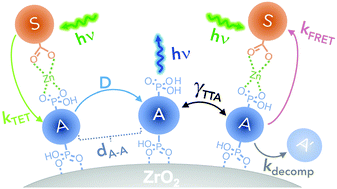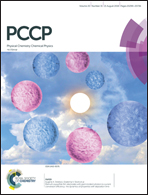Examining the role of acceptor molecule structure in self-assembled bilayers: surface loading, stability, energy transfer, and upconverted emission†
Abstract
Self-assembly of sensitizer and acceptor molecules has recently emerged as a promising strategy to facilitate and harness photon upconversion via triplet–triplet annihilation (TTA-UC). In addition to the energetic requirements, the structure and relative orientation of these molecules can have a strong influence on TTA-UC rates and efficiency. Here we report the synthesis of five different acceptor molecules composed of an anthracene core functionalized with 9,10- or 2,6-phenyl, methyl, or directly bound phosphonic acid groups and their incorporation into self-assembled bilayers on a ZrO2 surface. All five films facilitate green-to-blue photon upconversion with Φuc as high as 0.0023. The efficiency of TTA, and not triplet energy transfer, fluorescence, or losses via FRET, was primarily responsible for dictating the Φuc emission. Even for molecules having similar photophysical properties, variation in the position of the phosphonic acid resulted in dramatically different ΦTTA, Ith values, γTTA, and D. Interestingly, we observed a strong linear correlation between ΦTTA and the Ith value but the cause of this relationship, if any, is unclear.



 Please wait while we load your content...
Please wait while we load your content...
